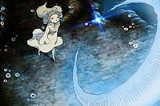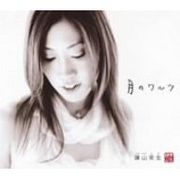
Tsuki no Warutsu
Encyclopedia
, literally Waltz of the Moon, is a 2004 Japan
ese anime
music video
created for the popular NHK
program Minna no Uta
by director Atsuko Ishizuka
and Studio Madhouse
.
network NHK
, had taken notice of Atsuko Ishizuka while she was still in college. Initially a student of graphic design, Ishizuka had taken to animation and produced several short films entirely on her own before being hired by Madhouse. It was shortly after being hired that Minna no Uta contacted her to direct a music video for their program. Convinced by the Minna no Uta staff, Madhouse promoted the low-ranking Ishizuka (then a production assistant) to director, and lent the studio's resources to the production.
After production was completed, the music video was shown on Minna no Uta broadcasts from the beginning of October through November 2004. Its success later prompted NHK to order another short from Ishizuka and Madhouse, Sen no Hana Sen no Sora, in 2005.
 The song of the same name which the short was animated to was composed and sung by the young musical vocalist Mio Isayama. The song was later released as Isayama's 8th single on December 1, 2004. The lyrics were penned by Reiko Yukawa, long known in Japan as a prominent music critic, and the arrangements were by Jun Abe, known for composing the music of the popular anime Kodomo no Omocha and Fruits Basket
The song of the same name which the short was animated to was composed and sung by the young musical vocalist Mio Isayama. The song was later released as Isayama's 8th single on December 1, 2004. The lyrics were penned by Reiko Yukawa, long known in Japan as a prominent music critic, and the arrangements were by Jun Abe, known for composing the music of the popular anime Kodomo no Omocha and Fruits Basket
.
in the last few years." The film was also popular enough to receive a home video release.
Japan
Japan is an island nation in East Asia. Located in the Pacific Ocean, it lies to the east of the Sea of Japan, China, North Korea, South Korea and Russia, stretching from the Sea of Okhotsk in the north to the East China Sea and Taiwan in the south...
ese anime
Anime
is the Japanese abbreviated pronunciation of "animation". The definition sometimes changes depending on the context. In English-speaking countries, the term most commonly refers to Japanese animated cartoons....
music video
Music video
A music video or song video is a short film integrating a song and imagery, produced for promotional or artistic purposes. Modern music videos are primarily made and used as a marketing device intended to promote the sale of music recordings...
created for the popular NHK
NHK
NHK is Japan's national public broadcasting organization. NHK, which has always identified itself to its audiences by the English pronunciation of its initials, is a publicly owned corporation funded by viewers' payments of a television license fee....
program Minna no Uta
Minna no Uta
, literally Everyone's Songs, is a five minute NHK TV and radio program broadcasting several times daily since 1961. The program is generally used as filler at the end of regular television programs...
by director Atsuko Ishizuka
Atsuko Ishizuka
is a Japanese animator and director at Madhouse, one of the leading animation production companies in the world. She was born on September 30, 1981 and has been with Madhouse since 2004.-Personal history:...
and Studio Madhouse
Madhouse (company)
is a Japanese animation studio, founded in 1972 by ex–Mushi Pro animators including Masao Maruyama, Osamu Dezaki, Rintaro, and Yoshiaki Kawajiri. It has created and helped to produce many well known shows, starting with TV anime series Ace o Nerae! in 1973, and including western favourites Ninja...
.
Production
Minna no Uta, a showcase for independent Japanese animators and musicians presented on the public broadcastingPublic broadcasting
Public broadcasting includes radio, television and other electronic media outlets whose primary mission is public service. Public broadcasters receive funding from diverse sources including license fees, individual contributions, public financing and commercial financing.Public broadcasting may be...
network NHK
NHK
NHK is Japan's national public broadcasting organization. NHK, which has always identified itself to its audiences by the English pronunciation of its initials, is a publicly owned corporation funded by viewers' payments of a television license fee....
, had taken notice of Atsuko Ishizuka while she was still in college. Initially a student of graphic design, Ishizuka had taken to animation and produced several short films entirely on her own before being hired by Madhouse. It was shortly after being hired that Minna no Uta contacted her to direct a music video for their program. Convinced by the Minna no Uta staff, Madhouse promoted the low-ranking Ishizuka (then a production assistant) to director, and lent the studio's resources to the production.
After production was completed, the music video was shown on Minna no Uta broadcasts from the beginning of October through November 2004. Its success later prompted NHK to order another short from Ishizuka and Madhouse, Sen no Hana Sen no Sora, in 2005.
Animation Style
The film is animated in Ishizuka's "moving sketch" style, giving the short the look of a hand drawn and colored pencil work. The animation and designs are not smooth or 'cleaned up,' giving them a rougher feel. This is stylistic continuation of Ishizuka's earlier solo works CREMONA and Gravitation, and has traditionally been a style more often seen in independent world animation rather than studio-produced anime. The animation itself was done by Madhouse veteran Yoshinori Kanemori. Despite the appearance, Tsuki no Warutsu was done in much the same way as Madhouse's normal anime, using the technique of digital ink & paint for the coloring. Great care was taken to disguise and cover these modern productions aids and ensure that the film look as hand-crafted and individual to Ishizuka's style as possible.Music

Fruits Basket
, sometimes abbreviated , is a Japanese shōjo manga series written and illustrated by Natsuki Takaya. It was serialized in the semi-monthly Japanese magazine Hana to Yume, published by Hakusensha, from 1999 to 2006. The series was also adapted into a 26-episode anime series, directed by Akitaro...
.
Reception
According to Benjamin Ettinger of AniPages Daily, Ishizuka received "literally thousands of posts on the BBS at her home page" after Tsuki no Warutsu was aired. Ettinger himself called the film "probably among the best pieces made for the show Minna no UtaMinna no Uta
, literally Everyone's Songs, is a five minute NHK TV and radio program broadcasting several times daily since 1961. The program is generally used as filler at the end of regular television programs...
in the last few years." The film was also popular enough to receive a home video release.

